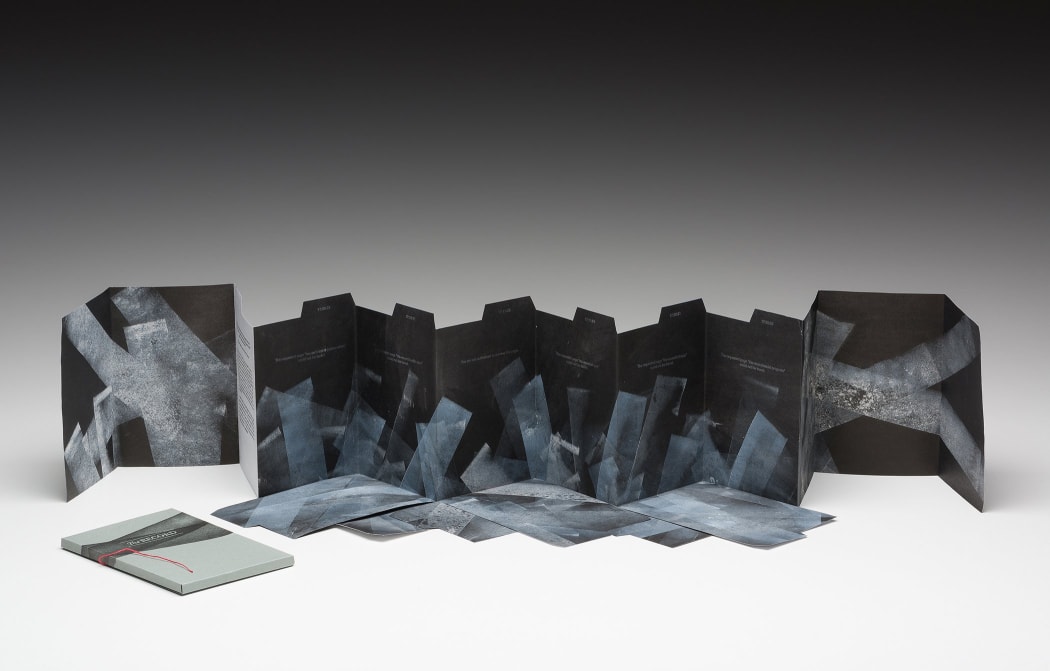
form & concept is proud to present the Partners in Art program, which highlights vital organizations in our community’s creative ecosystem. This month's partner is 23 Sandy, a legendary online book arts gallery that recently changed owners. At the tail end of a remarkable mentorship, gallery founder Laura Russell handed the reigns to Santa Fe artist and former 23 Sandy employee Erin Mickelson. She recalls, "I said I should probably sleep on it, and then five minutes later, I was like, 'Yes, of course! How could I say no?'"
Read our interview with Mickelson below, and consider acquiring a featured artwork from the 23 Sandy collection. All proceeds go directly to the gallery and artists, so please support if you're able. Mickelson is also this week's featured artist in our ongoing series of studio releases. Check out her new series of suminagashi print folios, Seen // Unseen.

Pliant History by Lindsay Lochman and Barbara Ciurej, 2017.
You’ve recently inherited 23 Sandy, a 13-year-old Portland, OR book arts gallery that was founded by Laura Russell and moved to an all-online model in recent years. Give me the origin story of 23 Sandy as you know it.
I only know bits and pieces of the very beginning. Laura is a book artist and a photographer. I believe she started 23 Sandy with the intention of focusing on photographic artist books. From what I understand, that took hold to some degree, but people just really responded to artist books that weren’t necessarily focused on photography. It evolved into this more all-encompassing artist book gallery.
How did you get involved in book arts?
I was living in Madison, Wisconsin, which is where I grew up. I was working as a graphic designer, but I was getting really sick of just sitting at a computer all day and staring at a screen. I was a freelancer, and I had one main client but I would branch out a little bit. I ended up having a job designing invitations, and they were letterpress.
I didn’t have experience with letterpress, so I sourced it out to a friend, and she had me come in and help her design and print. It was just so magical to me, and that opened up a whole world. I started learning about printing, and that led into book binding. It was this whole other world, and I wanted to be a part of it.
What was so intriguing to you about the leap from digital to analog?
Well, I owe that interest partly to the graphic design program I was in. They were really good about teaching us the older processes and techniques, like printmaking and life drawing.
The reason I was so emphatic about switching from digital to analog-focused work was the kinetic aspect of it. You just experience things and absorb things so much differently when there is a haptic aspect to what you’re doing.
That was something I thought a lot about. In addition to doing design work, I was teaching ballet technique. I was thinking a lot about what physical engagement and movement meant, and how it transpired across different fields and manifested. With both books and ballet, you physically and temporally move through the artworks, that’s how you absorb them.
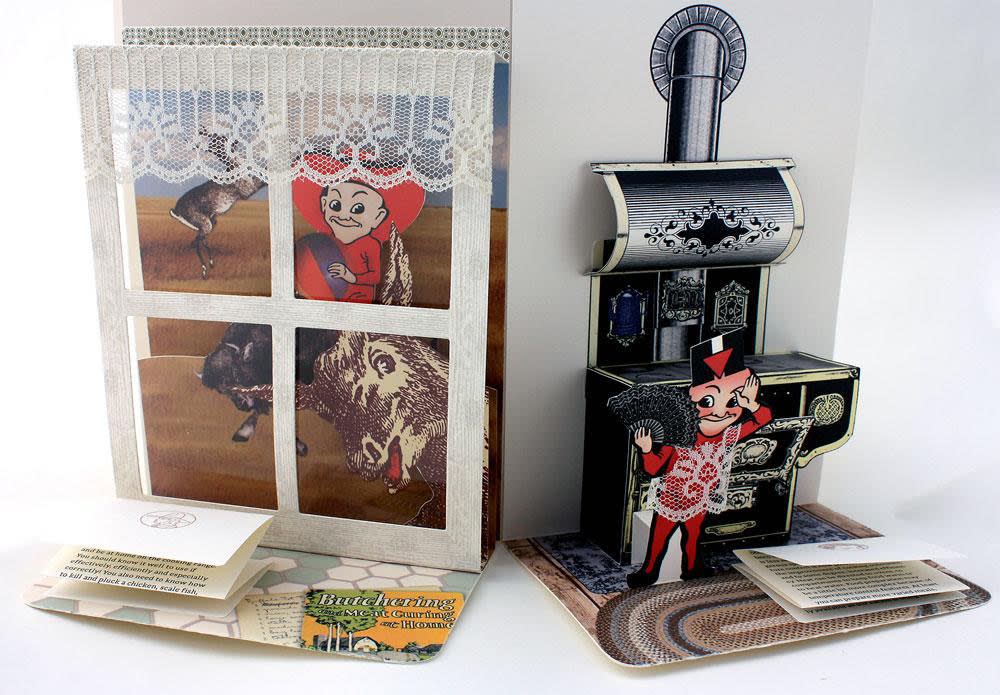
When the Veil Becomes the Apron by Elsi Vassdal Ellis, 2016.
And where did 23 Sandy first intersect with your story?
I started researching programs where I could study book arts. At the time, one of the best-known and rarest book arts programs was at the Oregon College of Art and Craft in Portland. I was looking into applying, and it was a tight timeline, but I ended up getting accepted and I moved out there for the following term. Laura had started the gallery in 2007, and I moved out to Portland, Oregon in 2010 to study.
Going to OCAC was how I met Laura. I was a first-year book art student, and Barb Tetenbaum was the head of the department. She was a pretty big mentor for me. For one of her book arts classes, she invited Laura to talk about marketing and galleries, and where you can find resources as a book artist. I was so excited and impressed by this idea of a gallery that was entirely focused on book artists.
At the end of the lecture, I very nervously approached Laura and asked her if she was looking for an intern or anything. She actually happened to be in a transitional point at that time. She had an intern who had recently left, so she was open to that. She said yes, so I started going into the gallery. The first thing she had me do was go through inventory, which was great. It was so different to actually hold the art and view it.
Tell me more about your experience as an intern at 23 Sandy.
There are so many amazing artists. I got to stare at their incredible work all day, and be inspired in my own work. I learned so much about the field of book arts while I was there. Moving through a book is a time-based, sequential experience. It can be linear or nonlinear with artist books. It makes it an unusual art form in that regard.
You have to make your own discoveries. You have to work for it. Artist books can be challenging, they’re not necessarily what we would expect in a trade book that we would read. You kind of have to figure things out—how to handle it, how to move through it.
How did you encourage that in the gallery space?
That was our big thing at the gallery, we wanted people to be able to handle the work and experience it for themselves. There was a big table. People could come into the gallery, and pick up books from the inventory and bring them to the table—after cleaning their hands of course. There was a lot of gratification in watching people interact with the work.
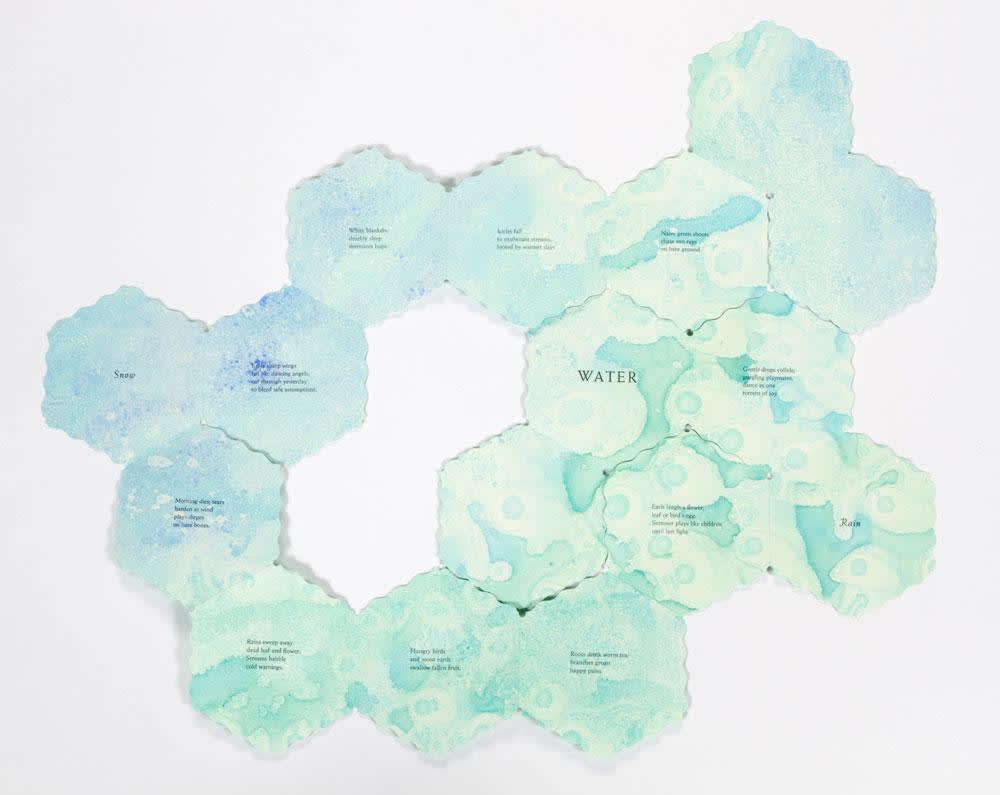
Water by Shu-Ju Wang, 2014.
The gallery hosted 91 exhibitions during its existence as a physical space. What was your part in that central initiative?
A lot of what we did was centered around the exhibitions. There were solo exhibitions, and group exhibitions that Laura would curate around a theme. But the big projects were the international juried exhibitions. I helped with designing prospectuses, planning, marketing, calls for submissions, displaying the work. That was how Laura discovered a lot of new artists to include in the inventory and to represent.
How did gallery visitors react? Like you said earlier, a book arts gallery seems like such a special and exciting thing.
We had a steady flow of regulars, and it was always fun to chat with them and catch up, and show them the new work. There were people who would come in and were totally unfamiliar with artist books. That was fantastic. It’s not a super known part of the art world, it’s a little hidden I guess. To see them discover that books can be art in this way was exciting.
What was your intro when first-time visitors came in?
I would tell them that a painter’s medium is paint, and sculptors work with clay, and book artists use the book as their medium. These are art objects that are made using elements of the book. Text and image, structure, material.
There’s definitely a gap between being told—where they’ll look at you and nod—and experiencing the work. They would leave with a new understanding after actually handling an artist book and interacting with it.
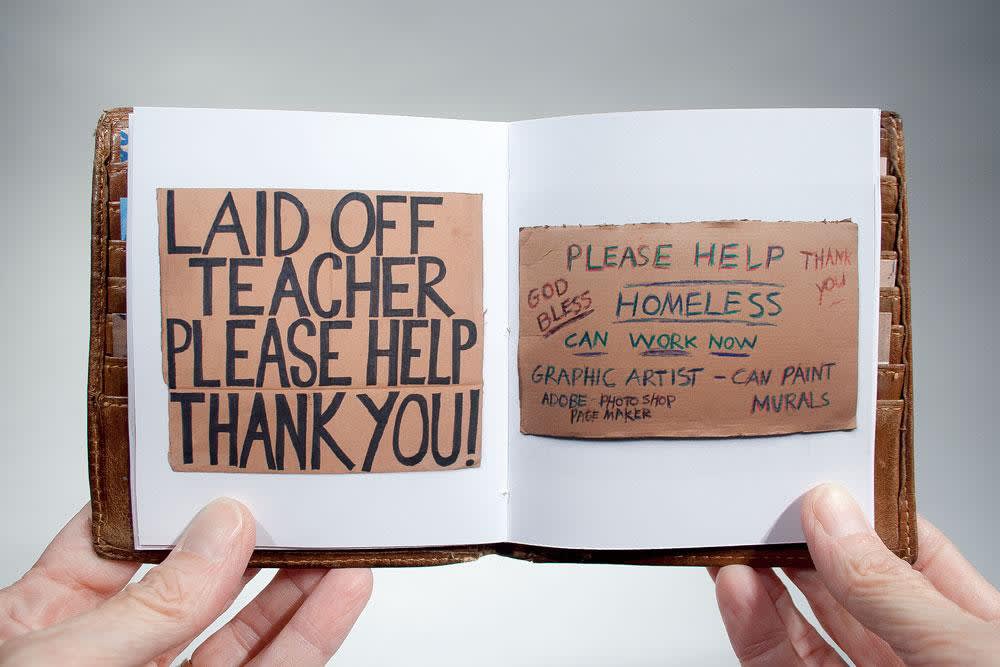
Anything Helps by Laura Russell, 2013.
How long did you work at 23 Sandy, and how did your role there evolve?
As time went on, and I became more of a fixture there, I got more involved in helping with the juried shows. About a year after I’d started, Laura tasked me with curating an exhibition. She directed me in all the different aspects. I curated INKED!, which was an invitational that featured contemporary Pacific Northwest letterpress printers.
That was a valuable learning experience. After that, she gave me the back gallery space to curate and exhibit work myself. I was running this little gallery-within-a-gallery. It was called Back Matter. I was featuring not necessarily just book artists, but emerging artists who were working with processes that book artists use. I would feature printmakers and papermakers.
I was there for four years, and I would’ve been there longer, but then I moved to Santa Fe. That was the only reason I left, because of the relocation to here.
Is there an artist you worked with at 23 Sandy or Back Matter who stands out as a particularly strong source of inspiration for your own artwork?
Nancy Prior, she was a printmaker who was focused on etching. She had done a residency, and had done this whole series of ocean etchings. She was letting the ocean etch her plates. The idea that you could collaborate with nature in that way was so exciting to me, and it opened up so many possibilities for my own work. Now I try to include an unexpected collaborator in most of what I do.
How did 23 Sandy end up moving to an all-digital model and closing its physical space?
Laura closed the physical gallery space in 2017, two years after I’d moved to Santa Fe. When she told me that she was closing the gallery, I was heartbroken. I remember having the irrational thought, “Maybe I could move back to Portland and keep it going somehow.” But it was okay, the shows could still continue in other spaces and Laura planned to continue the gallery online and through sales trips.

The Record by Anne Covell, 2017.
All right, let’s move forward to your life here in Santa Fe. How did you end up reconnecting with 23 Sandy, and eventually inheriting the business from Laura?
I had talked to Laura at the beginning of the year, and she told me she was ready to be done with running 23 Sandy and wanted to get into her studio to focus on her own practice. It felt like the end of an era, because Laura was such a big figure in the book arts community. It was sad to think that 23 Sandy was just going to be done and gone. But I was focused on my own work, and working in a bookbinding and letterpress studio as well.
A month and a half into the pandemic, I got confirmation that my contract work in the studio would not be returning, at least not in a feasible capacity, so I started thinking about what I could do next. I remembered the conversation with Laura in January. I wondered if I would be stepping on her toes in any way if I started my own business dealing artist books. I knew she was ready to be done, and maybe it would be fine with her if I started doing the same thing.
I woke up the next morning, and ended up going on a drive to Lamy, New Mexico. I was just driving, thinking. I stopped and I sent a text to Laura, and asked if she’d be able to talk that day. We caught up a little bit by phone, and then I mentioned my idea and asked her what she thought of it. As always, she was beyond supportive. She was so excited, offered to help me in any way I needed, offered to make introductions. Just like when I had my internship and she was allowing me these larger responsibilities.
How did the conversation evolve from starting your own business to acquiring 23 Sandy?
Laura had told me that one of the first things I needed was a name for my new business. I sent her a text later that day asking her opinion on an idea. She responded saying she liked the name, but then said, “or… what about 23 Sandy?” She was offering to hand me the business. My gut reaction was, “Wow! What a dream! Yes!” Then I had this moment of thinking, “This is a really big deal. These are big shoes to fill.” I said I should probably sleep on it, and then five minutes later, I was like, “Yes, of course! How could I say no?”
I went from being so upset and disappointed—losing my work, not knowing what direction to go next—to being handed this legacy. It’s this thing that Laura grew from the ground up, and she made it so successful and amazing. I feel a lot of anxiety and pressure about that sometimes. Not pressure from her at all, just pressure from myself to continue her work and do it well. These relationships that she built with institutions and clients—to just be handed all of that was incredible.
Laura’s transition to an online gallery model in 2017 seems quite prescient, in light of pandemic conditions that limit in-person art experiences. What are some challenges and opportunities there, when it comes to showing and selling artist books?
It’s difficult of course to experience an artist book in a digital space. A lot of Laura’s work was traveling. She would do sales trips, and go to conferences and share work there. Even though it was an online gallery, there was still a physical element. Of course right now that isn’t a thing, and we don’t know when it’s going to be a thing again.
Something that I’ve been thinking about with the online gallery is ways to bring that physical experience closer to online viewers. Things like video, because it gives you a better sense of the physicality of the book if you can see someone demonstrating it. That’s something I think about in my own work, is how the physical and digital can cross over.
Since everybody has been rethinking analog systems and jumping onto digital platforms, 23 Sandy’s clients are discovering that it’s actually not that difficult to interact digitally. I’m hoping to jump onto that momentum. I’m definitely looking at other organizations that are sort of leading the way in that, whether it’s Zoom demonstrations or video elements on the website. San Francisco Center for the Book has been doing a lot of interesting things digitally these days.
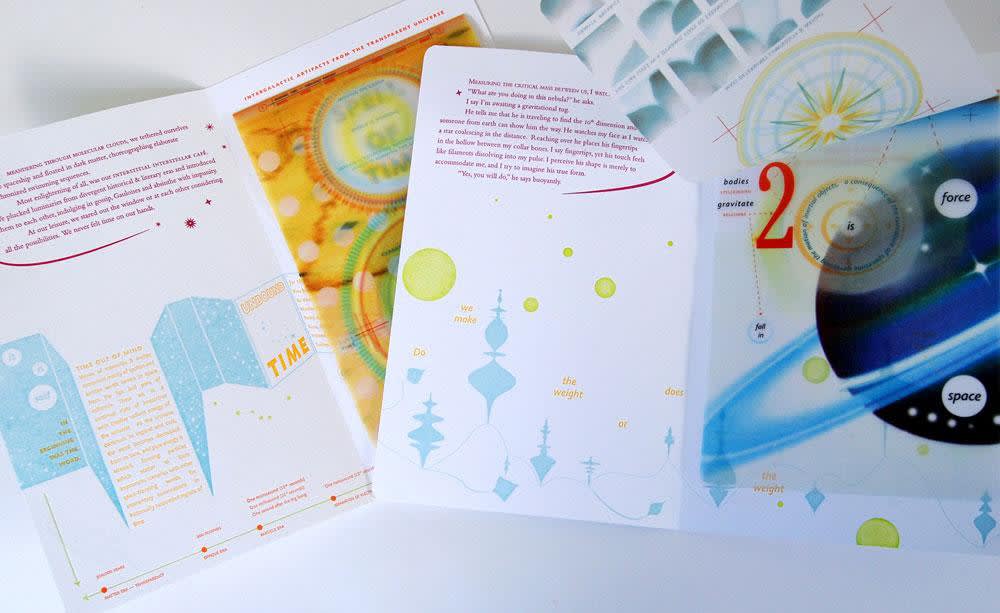
Matter, Antimatter and So Forth by Casey Gardner, 2013.
One of your first steps to taking on 23 Sandy, aside from learning Laura’s impeccably organized inventory and accounting systems, was relaunching the website. What did you learn about 23 Sandy from that project?
I was rebuilding and migrating a website with over 1,000 products and 500 blog posts to a new platform. I had to go into every single blog post and adjust formatting. I had to go into a lot of the individual products and edit things. But it was very much a labor of love. It was like reliving the history of the gallery. It was fascinating to see stuff from the few years before I was there, and it was a lot of fun to see blog posts mentioning the first events that I’d been at as an intern and favorite exhibitions over the years. It was a lot of work, but it was good to do it.
How do you hope to grow or change 23 Sandy, now that you’re at the helm?
Looking through our inventory and our artists, there’s a lot of great work. Book arts are great for exploring social and political themes, but we need more diversity in our artist roster. That is something that I’m currently taking a close look at to see what ways I can make that better. I’m so excited, and I have ideas that I’m looking forward to chatting with form & concept about.
Speaking of which, we’re working on an international juried book arts showcase in 2021 that will revive 23 Sandy’s physical program at form & concept! Are you excited for that?
I’m really looking forward to seeing all those artist books together in a physical space again. In the original 23 Sandy gallery, so much centered around the juried exhibitions. I already have a theme idea for this one. I’ve been thinking about the name of the exhibition being Unseen.
I love it. Stay tuned, form & concept community!
Explore artworks from 23 Sandy.
Comments
I am so glad you're doing this! Congratulations!
Congratulations! What beautiful art! I have shown with 23 Sandy on a number of occasions.
Thank you Jordan and Erin for this window into the evolution of 23 Sandy. We’re all missing physical openings and art exhibitions so I’m excited that Form and Concept is going to host a book art show. Yay! 👍🏻👍🏽👍🏾👍🏿
I'm excited to see your project go forward. Congratulations!
Neila Kun
